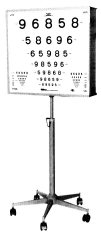Visual Acuity

According to the international recommendation,
visual acuity is measured with line acuity charts, i.e. the test is designed so
that the spaces between the optotypes are equal to the width of the optotypes and
the distance between the rows is equal to the height of the optotypes of the lower
row.
Ideally, the optotypes should blur equally. This is true with the LEA NUMBERS® 5, 6, 8 and 9. If some of the optotypes are easier to recognise, as in the set of the Sloan letters (EDTRS), then the number of easy and difficult optotypes on each line should not vary. Because the Sloan letters are not relevant in countries that use other types of letters, the LEA NUMBERS® optotypes were designed for international use, both in occupational health and in school health services.
In the examination of adult persons visual acuity is usually measured first at distance using a chart and near vision acuity after that either with a near vision card or as reading acuity. It is wise to measure visual acuity with the same optotypes at distance and at near. If the visual acuity values are notably different, there must be something wrong with the refractive correction that needs to be corrected before assessing reading performance. When testing visually impaired workers, reading acuity is best assessed by measuring the size of the smallest text the person can read and the critical text size, i.e. the text size until which reading speed increases (Reading Navigator).

Near vision test with  (#270900) contains a line test on the one side and a test with more tightly crowded numbers on the reverse side of the test card. The distance between the numbers on the crowded side is 50% of the width of the numbers on the left, 25% in the middle and 12.5% on the right of the test. A pocket near card is also available (#271000).
(#270900) contains a line test on the one side and a test with more tightly crowded numbers on the reverse side of the test card. The distance between the numbers on the crowded side is 50% of the width of the numbers on the left, 25% in the middle and 12.5% on the right of the test. A pocket near card is also available (#271000).
In vision screening the use of the near vision card improves the quality of screening and decreases the number of needless referrals. If a person's visual acuity at distance has decreased from an earlier measured value but visual acuity at near is the same as before, the person has become slightly myopic in that eye. Slight myopia in one eye does not require optic correction if it does not disturb the person.

|
In the measurement of visual acuity luminance level of the test varies on the commonly used charts hanging on the wall. Therefore lighboxes for translucent visual acuity charts have been developed to give a standard luminance independent of the illumination in the room. The large cabinet is for the EDTRS-size tests and the small lightbox for the smaller translucent tests. Detailed instructions on testing are in the Instructions Section. |
Vision in Occupational Health I Instructions for LEA Test System I Vision tests I Main page